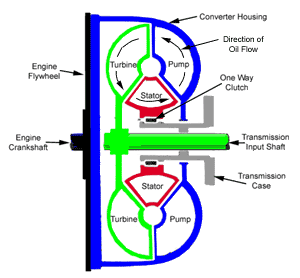I’m pretty sure it was my torque converter that went out, which is a costly repair to say the least. What is a torque converter you may ask?
Well, let me explain…
Torque Converter
On automatic transmissions, the torque converter takes the place of the clutch found on standard shift vehicles. It is there to allow the engine to continue running when the vehicle comes to a stop. The principle behind a torque converter is like taking a fan that is plugged into the wall and blowing air into another fan which is unplugged. If you grab the blade on the unplugged fan, you are able to hold it from turning but as soon as you let go, it will begin to speed up until it comes close to the speed of the powered fan. The difference with a torque converter is that instead of using air, it uses oil or transmission fluid, to be more precise.
A torque converter is a large doughnut shaped device (10" to 15" in diameter) that is mounted between the engine and the transmission. It consists of three internal elements that work together to transmit power to the transmission. The three elements of the torque converter are the Pump, the Turbine, and the Stator. The pump is mounted directly to the converter housing which in turn is bolted directly to the engine's crankshaft and turns at engine speed. The turbine is inside the housing and is connected directly to the input shaft of the transmission providing power to move the vehicle. The stator is mounted to a one-way clutch so that it can spin freely in one direction but not in the other. Each of the three elements have fins mounted in them to precisely direct the flow of oil through the converter
With the engine running, transmission fluid is pulled into the pump section and is pushed outward by centrifugal force until it reaches the turbine section which starts it turning. The fluid continues in a circular motion back towards the center of the turbine where it enters the stator. If the turbine is moving considerably slower than the pump, the fluid will make contact with the front of the stator fins which push the stator into the one way clutch and prevent it from turning. With the stator stopped, the fluid is directed by the stator fins to re-enter the pump at a "helping" angle providing a torque increase. As the speed of the turbine catches up with the pump, the fluid starts hitting the stator blades on the back-side causing the stator to turn in the same direction as the pump and turbine. As the speed increases, all three elements begin to turn at approximately the same speed.

So that’s what it is/does and without it working properly; my car is not working.
I was able to get it towed to my mans shop last Monday (finally) as well as acquire a low mileage JDM transmission complete with a working torque converter from a shop in Chicago. So basically my car, new/old transmission, and money are going to my man’s shop and there it well stay until he is able to fix it.
Needless to say, this is a bit of a financial set back in regards to what its going to take monetarily to get Project Legend completed but hey, that’s life.
New posts happening more than once a month.
Promise.

No comments:
Post a Comment